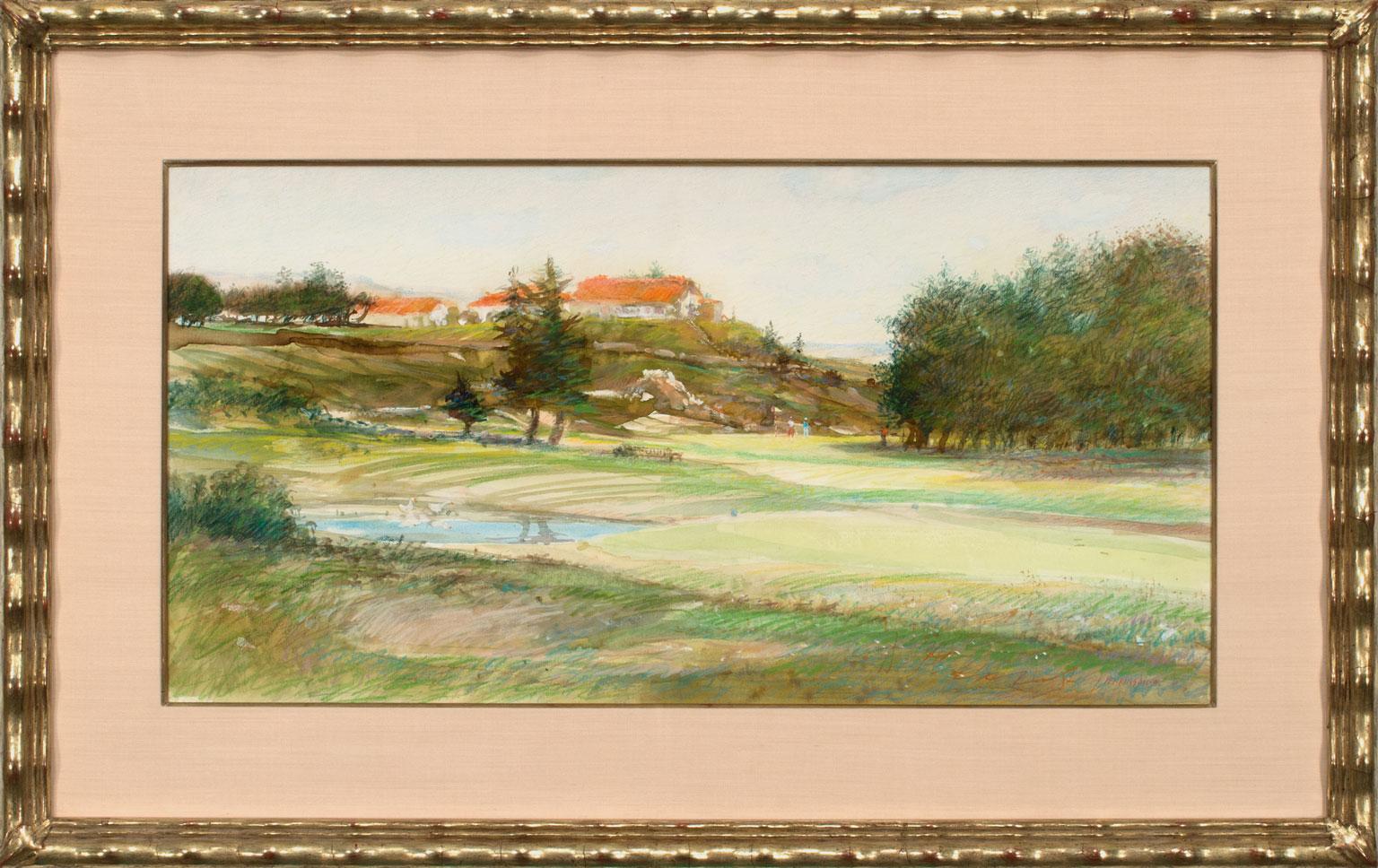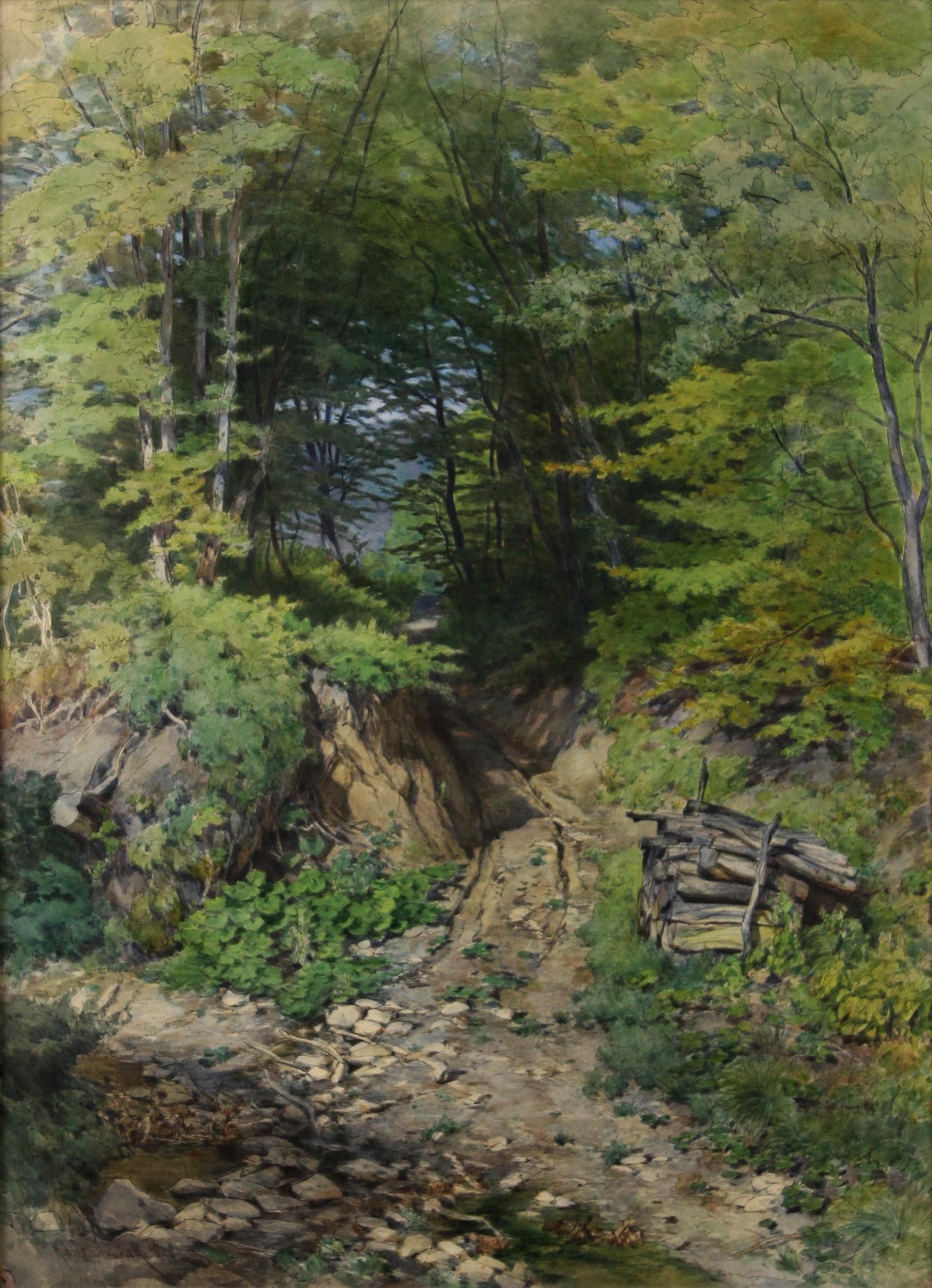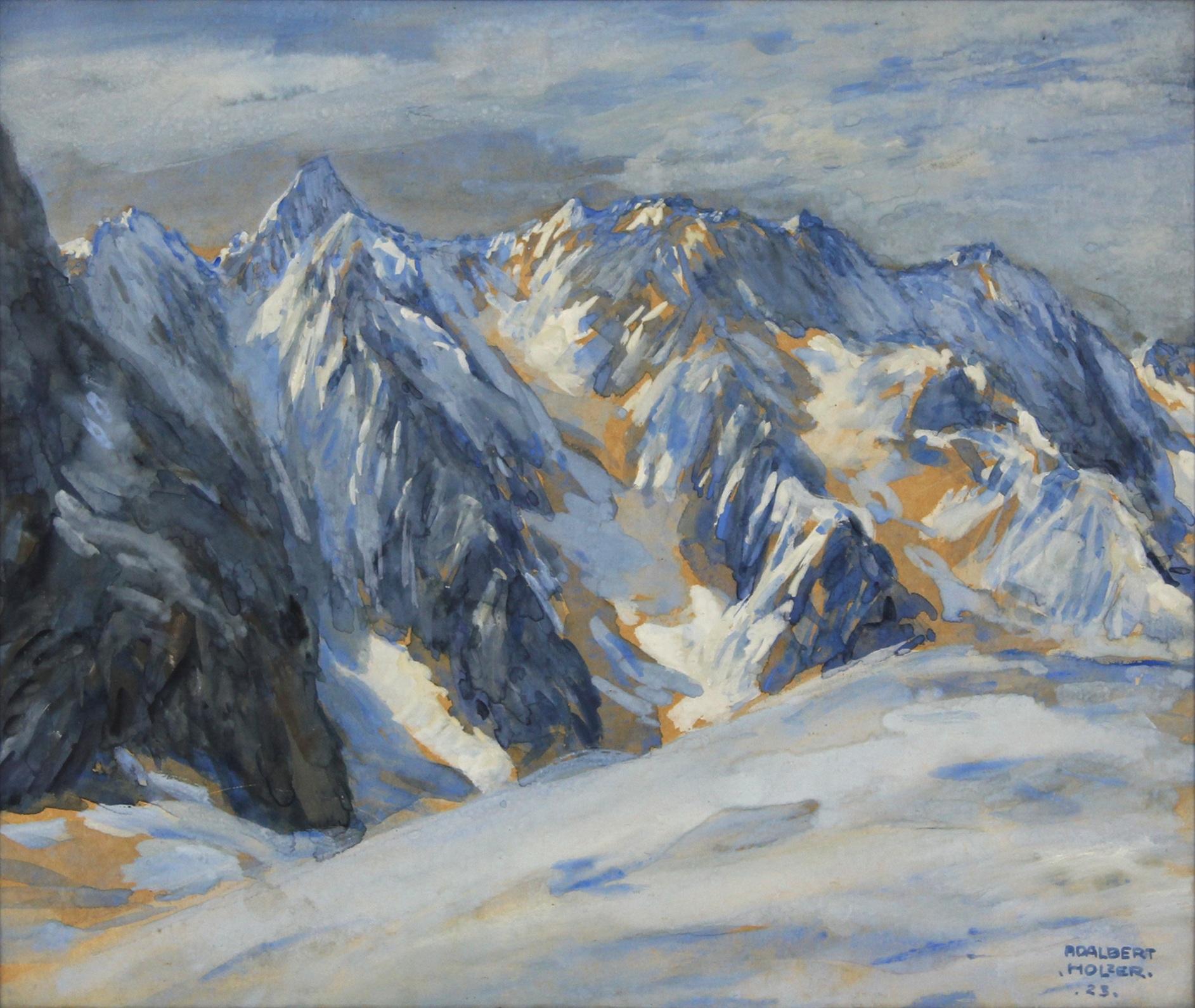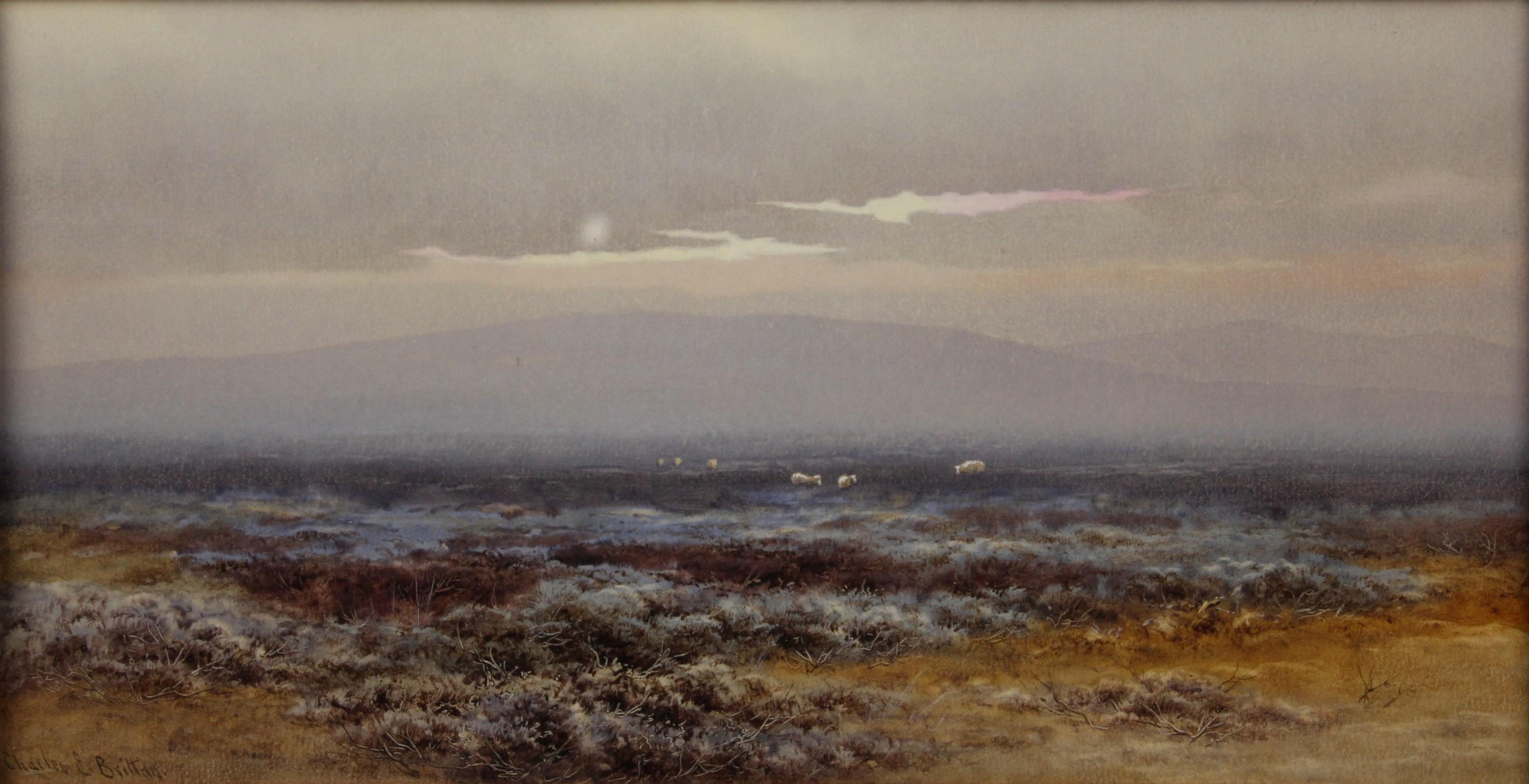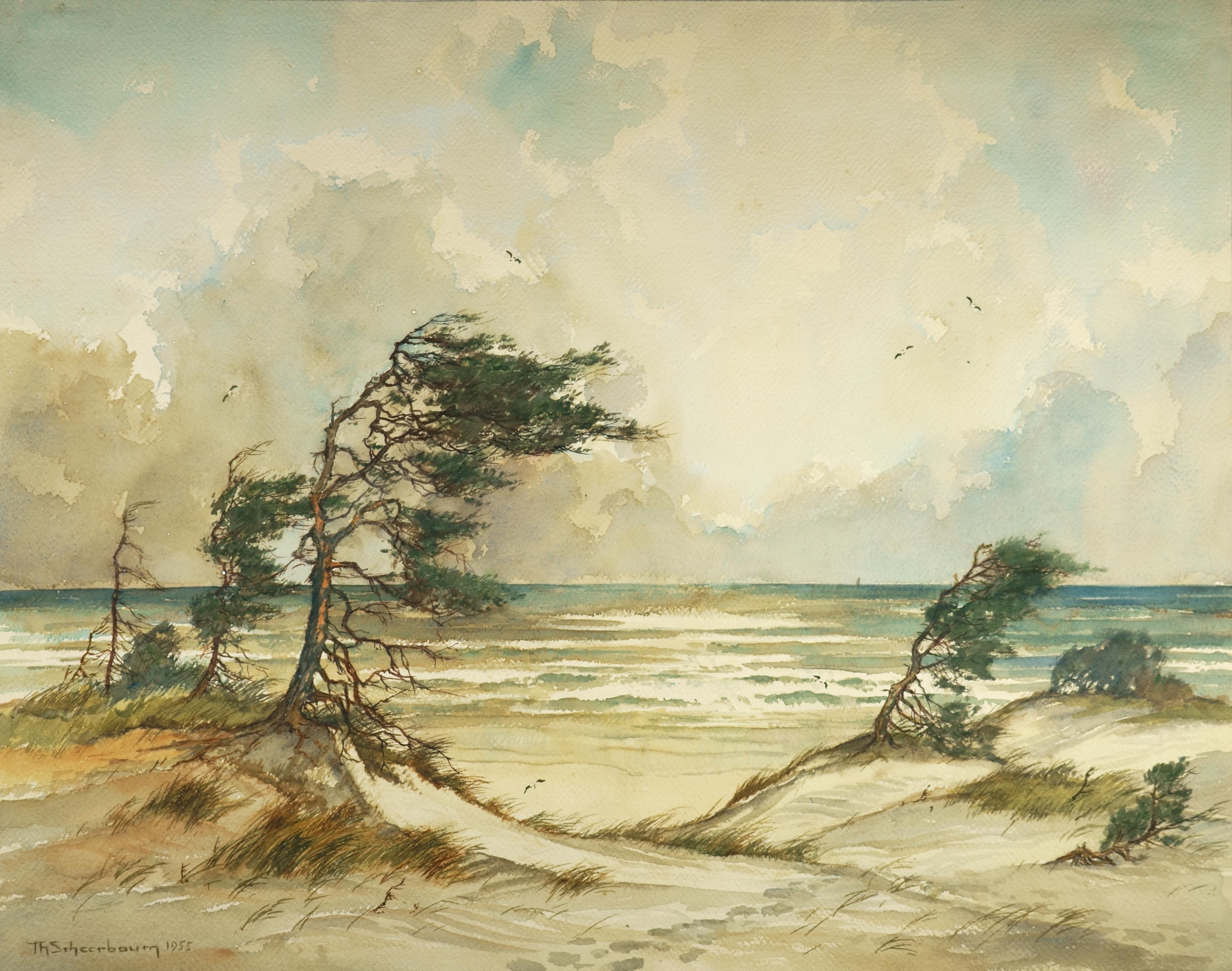Items Similar to Outgoing Fog (South Bristol, Maine)
Want more images or videos?
Request additional images or videos from the seller
1 of 8
Florian K. LawtonOutgoing Fog (South Bristol, Maine)1976
1976
About the Item
Watercolor on paper, 1976
Painted in South Bristol, Maine
Signed by the artist lower left
Condition: Excellent
- Creator:Florian K. Lawton (1921 - 2011)
- Creation Year:1976
- Dimensions:Height: 15 in (38.1 cm)Width: 22.875 in (58.11 cm)
- Medium:
- Movement & Style:
- Period:
- Condition:
- Gallery Location:Fairlawn, OH
- Reference Number:
About the Seller
5.0
Recognized Seller
These prestigious sellers are industry leaders and represent the highest echelon for item quality and design.
Platinum Seller
These expertly vetted sellers are 1stDibs' most experienced sellers and are rated highest by our customers.
Established in 1978
1stDibs seller since 2013
710 sales on 1stDibs
Typical response time: 1 hour
Associations
International Fine Print Dealers Association
- ShippingRetrieving quote...Ships From: Fairlawn, OH
- Return PolicyA return for this item may be initiated within 10 days of delivery.
More From This SellerView All
- Outgoing Fog (South Bristol, Maine)Located in Fairlawn, OHOutgoing Fog Watercolor on paper, 1976 Signed by the artist lower left Painted in South Bristol, Maine Condition: Excellent Watercolor size: 15 x 22 7/8 inches Frame size: 20 x 30 inches (aprox.) Florian...Category
1970s Realist Landscape Drawings and Watercolors
MaterialsWatercolor
- untitled (Hillside in Spring)By William C. GrauerLocated in Fairlawn, OHuntitled (Hillside in Spring) Gouache on paper, c. 1965 Signed with the estate stamp lower right Provenance: Estate of the artist by decent William C. Grauer (1895-1985) was born in Philadelphia to German immigrant parents. After attending the Philadelphia Museum School of Industrial Art, Grauer received a four year scholarship from the City of Philadelphia to pursue post graduate work. It was during this time that Grauer began working as a designer at the Decorative Stained Glass Co. in Philadelphia. Following his World War I service in France, Grauer moved to Akron, Ohio where he opened a studio in 1919 with his future brother-in-law, the architect George Evans...Category
1960s Realist Landscape Drawings and Watercolors
MaterialsGouache
- Italian CityscapeBy Victoria Hutson HuntleyLocated in Fairlawn, OHItalian Cityscape Pastel on Strathmore paper, 1968 Signed and dated lower right with the estate signature with the initials RH Image size: 13 3/4 x 10...Category
1960s Realist Landscape Drawings and Watercolors
MaterialsPastel
- untitled (Rocks along the Coast)By William C. GrauerLocated in Fairlawn, OHuntitled (Rocks along the Coast) Gouache and watercolor on paper, c. 1950 Signed with the estate stamp signature lower left (see photo) This is a preliminary study for a large exhibition painting...Category
1950s American Modern Drawings and Watercolor Paintings
MaterialsGouache
- Breaking Up of the PenelopeBy Edward DobrotkaLocated in Fairlawn, OHBreaking Up of the Penelope watercolor on artists watercolor board, 1942 Signed and dated by the artist lower right (see photo) Exhibitions: Cleveland, OH, The Cleveland Museum of Art, May 3 - June 11, 1944: "The 26th Annual Ehibition of Works by Artists and Craftsmen of the Western Reserve," , (label on verso) Youngstown OH, The Butler Insititue of American Art, 1943: "1943 New Year Show," , (label on verso) "Ed Dobrotka was one of comic-book illustrator Joe Shuster's early assistants. In the studio, he worked on the 'Superman' series, inking the pencils of artists including Shuster, John Sikela, Leo Nowak and Wayne Boring. Dobrotka did do some pencilling of his own, however he returned to inking exclusively in 1945. In the following years, he worked with Sikela on the 'Superboy' series until the 1950s. He has also work on the solo 'Lois Lane...Category
1940s American Realist Landscape Drawings and Watercolors
MaterialsWatercolor
- The Duomo, FlorenceBy Donald Shaw MacLaughlanLocated in Fairlawn, OHThe Duomo, Florence Watercolor, 1914 Signed and dated lower center edge (see photo) Florence Cathedral, formally the Cattedrale di Santa Maria del Fiore, is the cathedral of Florence, Italy. It was begun in 1296 in the Gothic style to a design of Arnolfo di Cambio and was structurally completed by 1436, with the dome engineered by Filippo Brunelleschi. Condition: Excellent Image size: 16 3/4 x 14 1/2 inches Frame size: 24 1/4 x 22 inches Donald Shaw MacLaughlan was born in Charlottetown, Prince Edward Island, Canada on November 9, 1876. His family moved to Boston, Massachusetts in 1890 where he began to experiment with different art media; watercolor, oil painting and finally, etching – with a few attempts at lithography. He spent much of his early years at the Boston Public Library studying the work of printmakers, from Durer and Rembrandt to the 18th century English, French and Italian masters. Like many American artists of the time MacLaughlan traveled to Europe to study in Paris, enrolling in the Ecole des Beaux Arts and studied further with Jean Leon Gerome and Jean Paul Laurens. In 1899 he began producing etchings, which became his major interest until his death in 1938. He became acquainted with James NcNeill Whistler (1834-1903) and other artists who created etchings and spent time studying the etchings of Rembrandt van Rijn (1606-1669) and other old masters in the collection of the Bibliothèque Nationale. Both Rembrandt and Whistler would have major influences on his art. In 1900 he created a set of 25 etched views of Paris and in 1901 exhibited two etchings in the Salon de la Société Nationale des Beaux-Arts. He returned to the U.S. in 1903, then went back to Paris the following year. He traveled extensively in Europe, visiting England, Switzerland, Italy and Spain as well as various locales in France. His etched views of Venice were well-known. MacLaughlan exhibited views of Paris, Rouen, Normandy and Italy in 1906 in a solo show at the American Art Association Galleries in Paris. He also displayed his work in the 1906 exhibitions of the Société Nationale des Beaux-Arts and the Société des Peintres-Graveurs Français. MacLaughlan even instructed other expatriate Canadian artists then living in Paris, most notably Clarence...Category
1910s American Modern Landscape Drawings and Watercolors
MaterialsWatercolor
You May Also Like
- "1940 - Number Nine" Original Mixed Media on Board by Tom Perkinson, FramedBy Tom PerkinsonLocated in Encino, CA"1940 - Number Nine" is an original mixed media on board by Tom Perkinson. His use of saturated violets, vivid yellows, and resplendent oranges pushes colo...Category
1980s Realist Landscape Paintings
MaterialsPastel, Ink, Mixed Media, Watercolor, Color Pencil
- Shady hollow way - Into the heart of the forest -By Hans DvoràkLocated in Berlin, DEHans Dvořák (19th century). Shady hollow way in a sunny forest. Watercolour and pen-and-ink drawing, 58.5 x 43 cm (visible size), 70 x 55.5 cm (frame), signed and dated "Hans Dvořák ...Category
1880s Realist Landscape Drawings and Watercolors
MaterialsWatercolor
- Wettersteinkamm - The blue of the mountains -Located in Berlin, DEAdalbert Holzer (1881 Munich - 1966 Munich). Wettersteinkamm. Watercolour, 29 x 34.5 cm (visible size), 37.5 x 43 cm (frame), signed and dated at lower right 'ADALBERT HOLZER [19]23'. Framed behind glass. Frame shows signs of wear. - The blue of the mountains - About the artwork The Wetterstein ridge is revealed to the viewer from a gentle, snow-covered hill. In contrast to conventional depictions of mountains, the painting is composed entirely of shades of blue, which condense into the blue-grey of the rock or fade into the white of the snow. As a complementary colour to the blue, Holzer virtuously activates the ochre ground. The uniform yet exciting polarity of the colours emphasises the massive majesty of the mountains and at the same time underlines the special character of the Wetterstein ridge. Holzer transferred the translucency of glass painting, in which he was originally trained, to watercolour and developed a pictorial language related to the art of Ferdinand Hodler, which earned him the nickname 'Master of Blue' and led to the appreciation of his watercolours in particular. About the artist After an apprenticeship as a stained glass painter at the Kunstgewerbeschule, Adalbert Holzer studied at the Munich Art Academy under Carl von Marr...Category
1920s Realist Landscape Drawings and Watercolors
MaterialsWatercolor
- High Moorland Landscape in the fog - The world as a transcendent phenomenon -Located in Berlin, DECharles Edward Brittan Jr (1870 Plymouth - 1949). High moor landscape in the fog. Gouache, signed at lower left "Charles E. Brittan", 18 x 34.5 cm (passepartout), 45 x 62 cm (frame)....Category
Early 20th Century Realist Landscape Drawings and Watercolors
MaterialsWatercolor
- Raft Landscape in Sweden / - Temporary structures -Located in Berlin, DEOtto Eglau (1917 Berlin - 1988 Kampen), Raft Landscape in Sweden, 1956. Watercolor and ink on paper, 45 x 60 cm, signed in his own hand lower right with "Eglau" and dated "[19]56". - somewhat darkened Exposé as PDF - Temporary structures - About the artwork A wide river landscape stretches out before us, its horizon line running across the upper part of the picture, creating the impression of enormous depth. The depth is further extended by the dark tree trunks, most of which spill into the picture, and at the same time rhythmized by their different positions. This sequence of movements gives the landscape a strong dynamic moment. Indeed, the landscape seems to be "fleeing" from beneath us. To keep the gaze on the foreground alone requires a real visual effort. By looking at the foreground, we have already arrived at the background. Therefore, we cannot speak of pictorial grounds in the classical sense. Rather, we are confronted with a structurally rhythmic continuum of space, the dynamics of which are further accelerated by the cut tree trunks in the foreground and the upright trunks in the background, which function as target marks. Since the narrow strip of sky has the same white tonality as the ice, this area also fits seamlessly into the spatial structure, so that a deserted "structural landscape" unfolds before us. The structure, however, is not - as in the case of Piet Mondrian - completely abstract and thus something that exists independently of itself, removed from the time of natural space. The structures that Otto Eglau discovered in nature remain bound to it, which is why they exhibit a temporality that corresponds to the 'course of things'. Even if they correspond to an architecture of nature brought to representation, the structures are not substantial, but contingent. Artistically uncovered, they present themselves to Eglau at the very moment he captures them. In nature itself, these structures will never be repeated in the same way. Panta rhei - everything flows, even if the flow of time is frozen by his artistic representation and the image, for all its dynamism, radiates calm at the same time. "The structures I put behind things, and the lines that hold my paintings, are signs of transient life. They are random like the trace a wave leaves in the sand, blurred like the border between sea and land, ephemeral like the life of a shell I hold in my hand." - Otto Eglau About the artist After his release from captivity in 1947, Otto Eglau studied at the Hochschule für Bildende Künste in Berlin. He was a student of Oskar Nerlinger, Max Kaus and Wolf Hoffmann. From 1953 he taught free drawing for architects at the Technical University of Berlin. In the years that followed, Eglau undertook numerous study trips that took him to Scandinavia, the Arab world, the Far East and even Macau. During these travels he cultivated the technique of watercolour, which allowed him to work quickly in the open air, while retaining a strong painterly quality. Scholarships enabled Eglau to stay in Japan from 1962 to 1963 and in Naples in 1970. From 1969 to 1976 Eglau was professor of etching at the International Summer Academy of Fine Arts in Salzburg. Between 1983 and 1988 Eglau worked simultaneously in his Berlin studio at Lietzensee, which had its own printing press, and in his studio in Kampen on the island of Sylt. Otto Eglau's work has been shown in more than 100 solo exhibitions worldwide and in more than 120 group exhibitions. "I love the vastness of the island. The mudflats off Kampen are my treasure trove; here I discover new shapes and colors every day. Without Sylt, I would be like a fish without water." - Otto Eglau Selected Bibliography Hanns Theodor Flemming: Otto Eglau. Das graphische Werk, Flensburg 1966. Heinrich Seemann (Einführung): Otto Eglau. Inselskizzen, Hamburg 1982. Heinrich Seemann (Einführung): Otto Eglau. Japan, Nepal, Sylt. Aquarelle. Zeichen und Strukturen. Einführung von Heinrich Seemann, Hamburg 1986. Otto Eglau: Watt-Tagebuch. Ausgewählte Aquarelle aus den Skizzenbüchern Otto Eglaus. Kampen 1996. GERMAN VERSION Otto Eglau (1917 Berlin – 1988 Kampen), Floßlandschaft in Schweden, 1956. Aquarell und Tusche auf Papier, 45 x 60 cm, unten rechts eigenhändig in Blei mit „Eglau“ signiert und mit „[19]56“ datiert. - etwas nachgedunkelt Exposé als PDF - Temporäre Strukturen - zum Werk Vor uns erstreckt sich eine weite Flusslandschaft, deren Horizontline im oberen Bereich des Bildes verläuft, wodurch der Eindruck einer enormen Tiefenerstreckung entsteht. Die Tiefe wird von den dunklen, zumeist ins Bild hineinfluchtenden Baumstämmen zusätzlich geweitet und – durch ihre verschiedenartigen Lagen – dabei zugleich rhythmisiert. Durch diese Bewegungsabfolge weist die Landschaft ein starkes dynamisches Moment auf. Und tatsächlich stellt sich der Eindruck ein, als ob die Landschaft unter uns ‚hinwegfluchten‘ würde. Den Blick einzig im Vordergrund zu halten, verlangt regelrecht eine visuelle Anstrengung. Auf den Vordergrund schauend sind wir bereits im Hintergrund angelangt. Daher kann gar nicht von Bildgründen im klassischen Sinne gesprochen werden. Vielmehr steht hier ein strukturell rhythmisiertes Raumkontinuum vor Augen, dessen Dynamik von den angeschnittenen Baumstämmen vorne und den als Zielmarken fungierenden aufgerichteten Stämmen hinten zusätzlich beschleunigt wird. Da der schmale Himmelstreifen dieselbe Weißtonalität wie die Wasserlandschaft aufweist, fügt sich auch dieser Bereich bruchlos in das Raumgefüge ein, so dass sich vor uns eine menschenleere ‚Strukturlandschaft‘ ausbreitet. Die Struktur ist aber nicht – wie dies bei Piet Mondrian der Fall ist – gänzlich abstrakt und dadurch etwas eigenständig für sich Bestehendes, das der Zeit des Naturraums enthoben ist. Die von Otto Eglau in der Natur entdecken Strukturen bleiben an diese zurückgebunden, weshalb sie eine dem ‚Lauf der Dinge‘ entsprechende Temporalität aufweisen. Auch wenn sie einer zur Darstellung gebrachten Architektur der Natur entsprechen, sind die Strukturen nichts Substanzielles, sondern kontingent. Künstlerisch aufgedeckt, bieten sie sich Eglau in eben jenem Moment dar, den er festhält. In der Natur selbst werden diese Strukturen niemals in derselben Art wiederkehren. Panta rhei – alles fließt, auch wenn sich der Fluss der Zeit durch seine künstlerische Darstellung verfestigt hat, wodurch das Bild – trotz aller Dynamik – zugleich auch Ruhe ausstrahlt. „Die Strukturen, die ich hinter die Dinge setze, und die Linien, die meine Bilder halten, sind Zeichen des vergänglichen Lebens. Sie sind zufällig wie die Spur, die eine Welle im Sand hinterlässt, unscharf wie die Grenze zwischen Meer und Land, vergänglich wie das Leben einer Muschel, die ich in der Hand halte.“ - Otto Eglau zum Künstler Nach seiner Entlassung aus der Kriegsgefangenschaft 1947 nahm Otto Eglau ein Studium an der Hochschule für Bildende Künste in Berlin auf. Dort war wer Schüler von Oskar Nerlinger, Max Kaus und Wolf Hoffmann. Ab 1953 unterrichtete er freies Zeichnen für Architekten an der Technischen Universität Berlin. In den Folgejahren unternahm Eglau zahlreiche Studienreisen, die ihn nach Skandinavien, in den arabischen Raum, nach Fernost und bis nach Macau führten. Auf diesen Fahrten kultivierte er die Technik des Aquarellierens, die eine zügige Bildschöpfung im Freiraum erlaubt und dennoch eine stark malerische Qualität aufweist. Stipendien ermöglichten es Eglau, sich von 1962 bis 1963 in Japan aufzuhalten und 1970 länger in Neapel zu verweilen. Von 1969 bis 1976 hatte Eglau die Professur für Radierung an der Internationalen Sommerakademie für Bildende Kunst in Salzburg inne. Zwischen 1983 und 1988 war Eglau parallel in seinem Berliner Atelier am...Category
1950s Realist Landscape Drawings and Watercolors
MaterialsWatercolor
- Wind Dodgers at the Baltic SeaLocated in Berlin, DETheodor Scheerbaum (1897 Reichenbach im Vogtland), Wind Dodgers at the Baltic Sea. Watercolor on strong yellowish grained paper, 44 x 56 cm, signed by hand "Th[eodor] Scheerbaum" at ...Category
1950s Realist Landscape Drawings and Watercolors
MaterialsWatercolor
